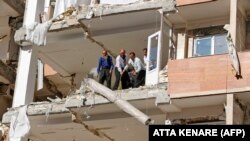Two moderately strong earthquakes hit eastern Iran in quick succession around 6:00 am local time on December 1.
The tremor was felt in in the cities of Zarand, Sirjan and Kerman, in south eastern Iran.
The U.S. Geological Survey said the first, a relatively strong magnitude 6.0 tremor, struck at a shallow depth close to the city of Kerman, which has a population of more than 821,000.
The quake's shallow depth of 10 kilometers would have amplified the shaking effects felt on the surface, the survey said.
It was followed up 10 minutes later by a second, less powerful 5.0 aftershock in the same area, the survey said.
Mohammad Saberi, the director of emergencies in Kerman University medical school told local media that around 50 people were injured, mostly during the panic that was ensued by the quake.
Mehr news agency says 39 injuries were in Kerman, which is the largest city in the area, and the rest in nearby towns and villages.
Residents of the city came out into the street as the quake struck, and drivers were seen rushing to stock up on gasoline, according to local media.
Kerman's crisis center was activated, and rescue teams from the Red Cross and local authorities headed to affected areas for preliminary evaluations, a local official told state television.
The University of Tehran's seismology center said the first quake had a magnitude of 6.1, followed by aftershocks of 5.1 and 4.
A magnitude 6.0 quake is considered strong and capable of causing severe damage. But USGS's modelling predicted a low chance of widespread loss to life or property.
The latest tremors come just over two weeks after a 7.3 magnitude quake killed more than 400 people in western Kermanshah Province, close to the border with Iraq.
Iran sits on top of two major tectonic plates and experiences frequent seismic activity.
In 1990, a 7.4-magnitude quake in northern Iran killed 40,000 people, injured 300,000 and left half a million homeless.
In 2003, a catastrophic quake flattened large parts of the ancient southeastern city of Bam, killing at least 31,000.
Iran experienced at least two major quake disasters after the Bam quake -- one in 2005 that killed more than 600 people and another in 2012 that left some 300 dead.
Based on reporting by Iranian agencies, AFP and Reuters





